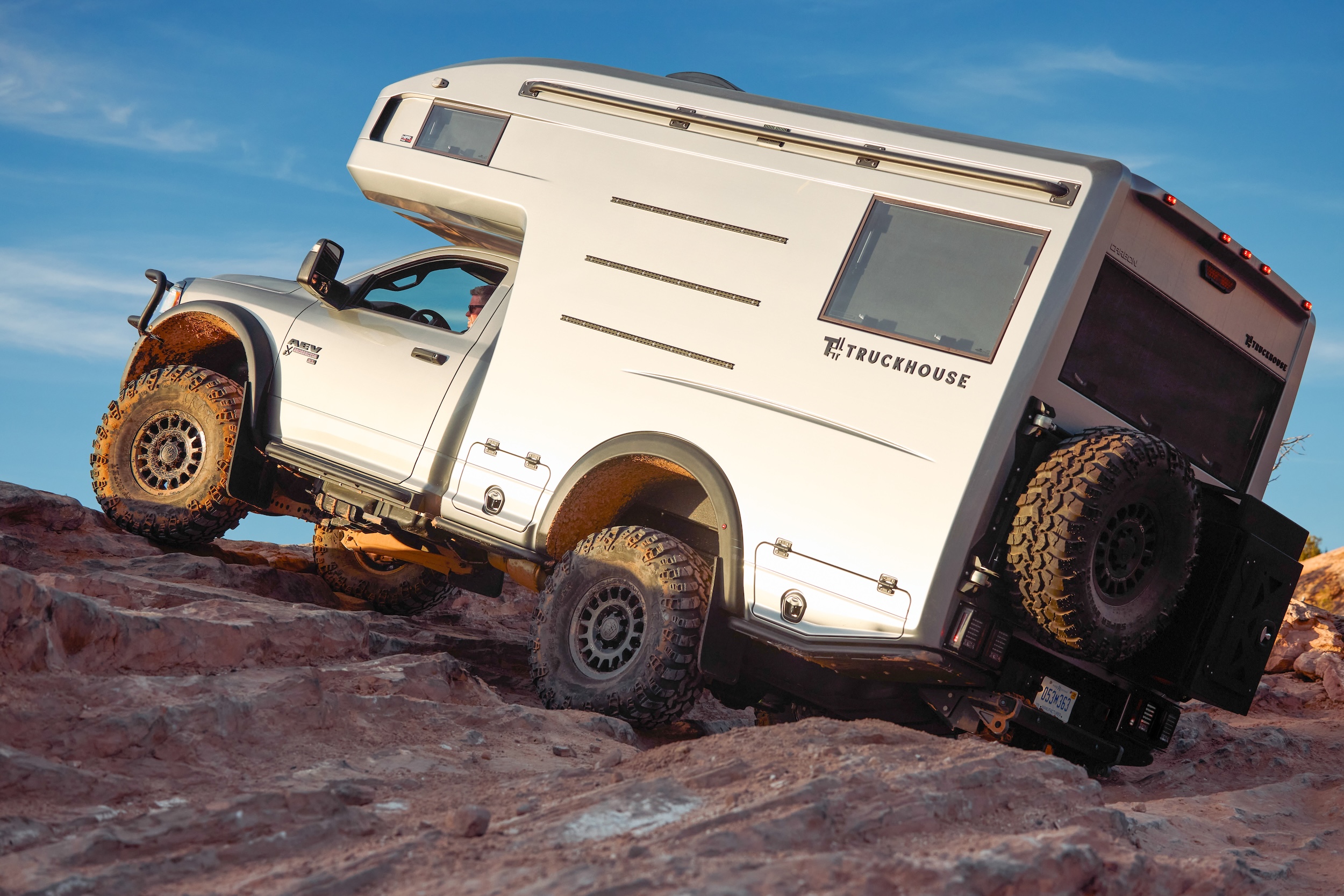In the world of expedition vehicles, TruckHouse has emerged as a disruptive force, offering a fresh approach to overland travel. By focusing on lighter weight, greater maneuverability, and cutting-edge engineering, the TruckHouse BCR is redefining what an expedition vehicle can be. With its innovative carbon monocoque construction, thoughtfully designed systems, and compact yet functional layout, the BCR challenges the long-standing dominance of EarthRoamer in the segment while carving out its own unique identity.
The Sweet Spot: Balancing Size, Comfort, and Capability
Overland travelers have long sought the ideal expedition vehicle—one that strikes a harmonious balance between capability, comfort, and maneuverability without leaning too far into excess. Many vehicles in this space prioritize luxury and size at the expense of agility and true off-road versatility, leaving adventurers with impressive interiors but limited access to the most challenging trails.
The TruckHouse BCR redefines this balance, offering a design that feels purpose-built for real-world exploration. Weighing between 12,000 and 13,500 pounds, depending on the configuration (gas or diesel, regular or crew cab), its lightweight carbon fiber monocoque construction eliminates the need for a bulky subframe. This approach not only sheds weight but also enhances strength and durability, allowing the BCR to thrive in scenarios where larger vehicles falter—tight trails, narrow forest roads, and technical off-road challenges.
“Our focus with the BCR was simple: build a vehicle that’s as reliable as it is capable,” says Matt Linder, CEO of TruckHouse. “We want our customers to spend their time camping in places they’ve only dreamed of, not troubleshooting mechanical issues.”
What truly sets TruckHouse apart, however, is its collaboration with American Expedition Vehicles (AEV). By teaming up with a proven leader in chassis and subframe engineering, TruckHouse leverages AEV’s expertise to ensure the RAM 3500 Prospector XL platform is perfectly tailored to the BCR’s needs. This partnership allows TruckHouse to focus on designing the camper while leaving the vehicle engineering to the experts—a stark contrast to many competitors attempting to juggle both roles.
For those prioritizing mobility, the optional single-cab configuration reduces the wheelbase to a nimble 143.5 inches, comparable to a Jeep Gladiator. Despite its compact size, the BCR doesn’t compromise on functionality. It offers a cabover king bed, a convertible dinette, and a functional galley—all thoughtfully integrated into its smart, space-efficient layout. Social spaces, extra sleeping capacity, and ample storage for extended trips complete the package.
For adventurers seeking a vehicle that feels equally at home navigating remote trails or winding mountain roads, the TruckHouse BCR demonstrates that a smaller, smarter, and more agile design can unlock a world of possibilities—both on and off the beaten path.
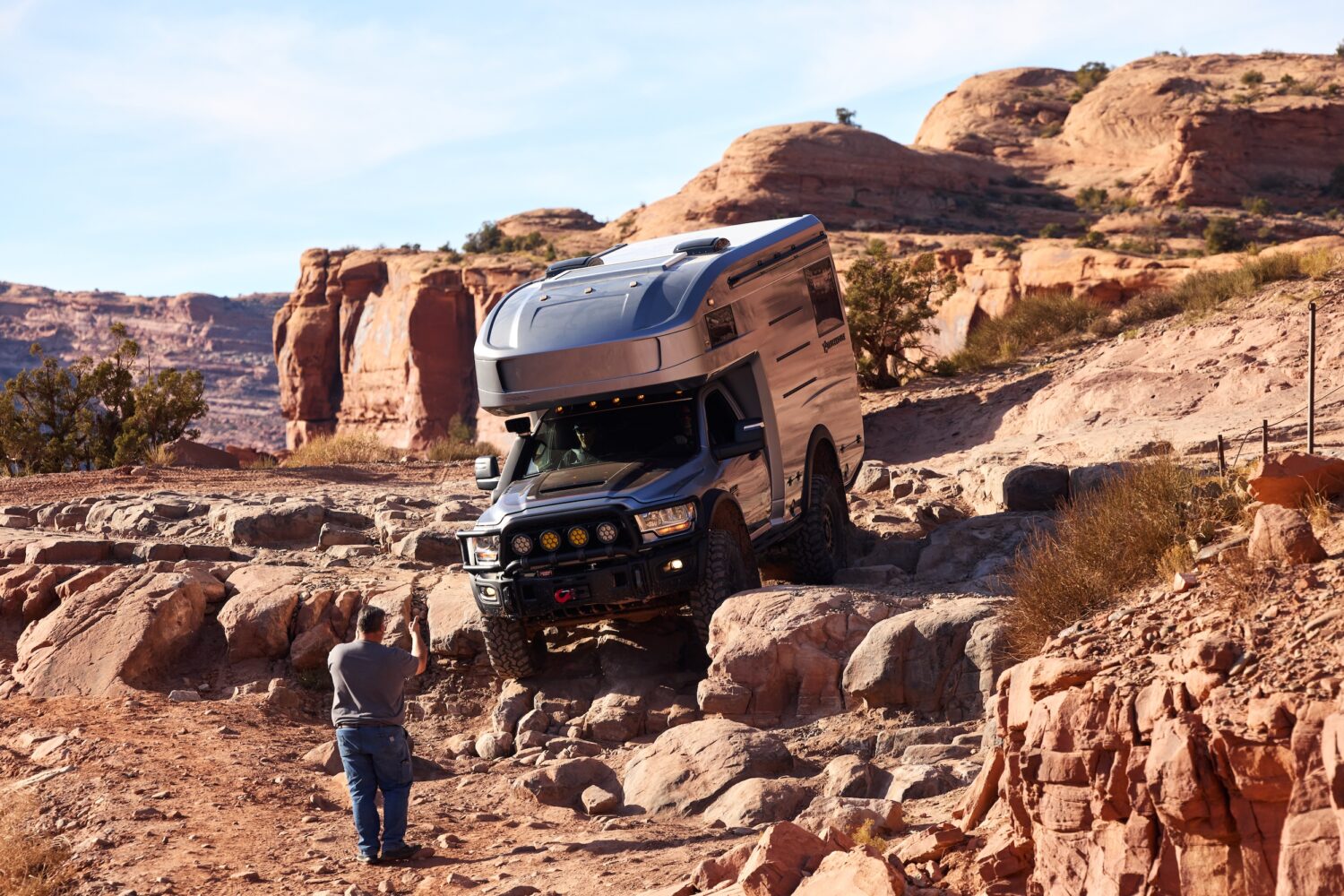
The rocky exit of the Hell’s Revenge Trail. Photo by Max Hall
Revolutionary Design: The Carbon Monocoque Advantage
TruckHouse’s carbon-fiber monocoque camper shell is a game-changer in expedition vehicle design, offering a combination of strength, weight savings, and aerodynamic efficiency that sets it apart from traditional builds. Seamlessly integrated with the Ram 3500 Prospector XL chassis, the monocoque eliminates the need for a heavy subframe, saving over 500 pounds and lowering the vehicle’s center of gravity. This weight reduction isn’t just about shaving numbers—it directly enhances the BCR’s agility, driving dynamics, and overall durability by reducing wear on key components.
Aerodynamics is another standout feature, with TruckHouse incorporating HiPR Foil (high pressure reduction) technology to streamline airflow. These patent-pending innovations manage drag and pressure buildup around the cabover, improving fuel efficiency, reducing wind noise, and delivering a quieter, more comfortable ride at highway speeds.
Inside, the BCR is built for comfort and functionality. Dual-pane windows and four-season insulation ensure a cozy environment in any climate, while single-piece molded cabinetry maximizes storage without adding unnecessary weight or complexity. The carbon monocoque camper shell also maintains its rigidity over rough terrain, thanks to TruckHouse’s innovative torsion-free mounting system.
This system, which isolates the camper from the chassis, allows the truck’s frame to flex as intended without compromising the structural integrity of the carbon shell. As Dave Harriton, founder of AEV and a key collaborator on the BCR project, explained: “One very interesting thing is that the cab chassis with the mounting system has greater articulation than our regular Prospectors.”
This difference comes down to how cab chassis frames are engineered. Unlike pickup chassis, which are designed to minimize flex for load-bearing purposes, cab chassis frames are built to allow controlled twist and flex. This flexibility, combined with TruckHouse’s torsion-free mounting system, results in greater articulation than even a standard Prospector XL, giving the BCR a distinct edge on technical terrain.

Durability testing in sand dunes. Photo by AJ Van de Water
Built for Reliability: A Simpler, Smarter Approach
One of the most significant advantages of the TruckHouse BCR lies in its more robust approach to engineering. While EarthRoamer utilizes a Kelderman-sourced air suspension, which earns points for on-road comfort and campsite leveling, this added complexity introduces potential failure points. A cracked air line or a burned-out air compressor, for example, can have serious consequences—especially in remote areas where repair options are limited or nonexistent.
TruckHouse, in collaboration with AEV, deliberately chose a more reliable “re-engineered” factory-style suspension setup for the BCR. As Dave Harriton explained, reliability was at the forefront of every decision. “The failure mode was the most discussed aspect for every decision,” he said. “This is life-and-death, vehicle-dependent travel—not walking across a ski area parking lot to a five-star hotel if something doesn’t work.”
Another crucial advantage of the TruckHouse BCR lies in its modularity. With minimal connections between the camper and truck—just six bolts, six waterproof connectors, and a single heater fuel line—the BCR can be removed from the chassis in about 40 minutes. This means that if major maintenance is ever required, downtime is drastically reduced. By contrast, EarthRoamer’s integrated design, while having its own advantages, makes camper removal—though rare in its necessity—a far more complex and time-consuming process.
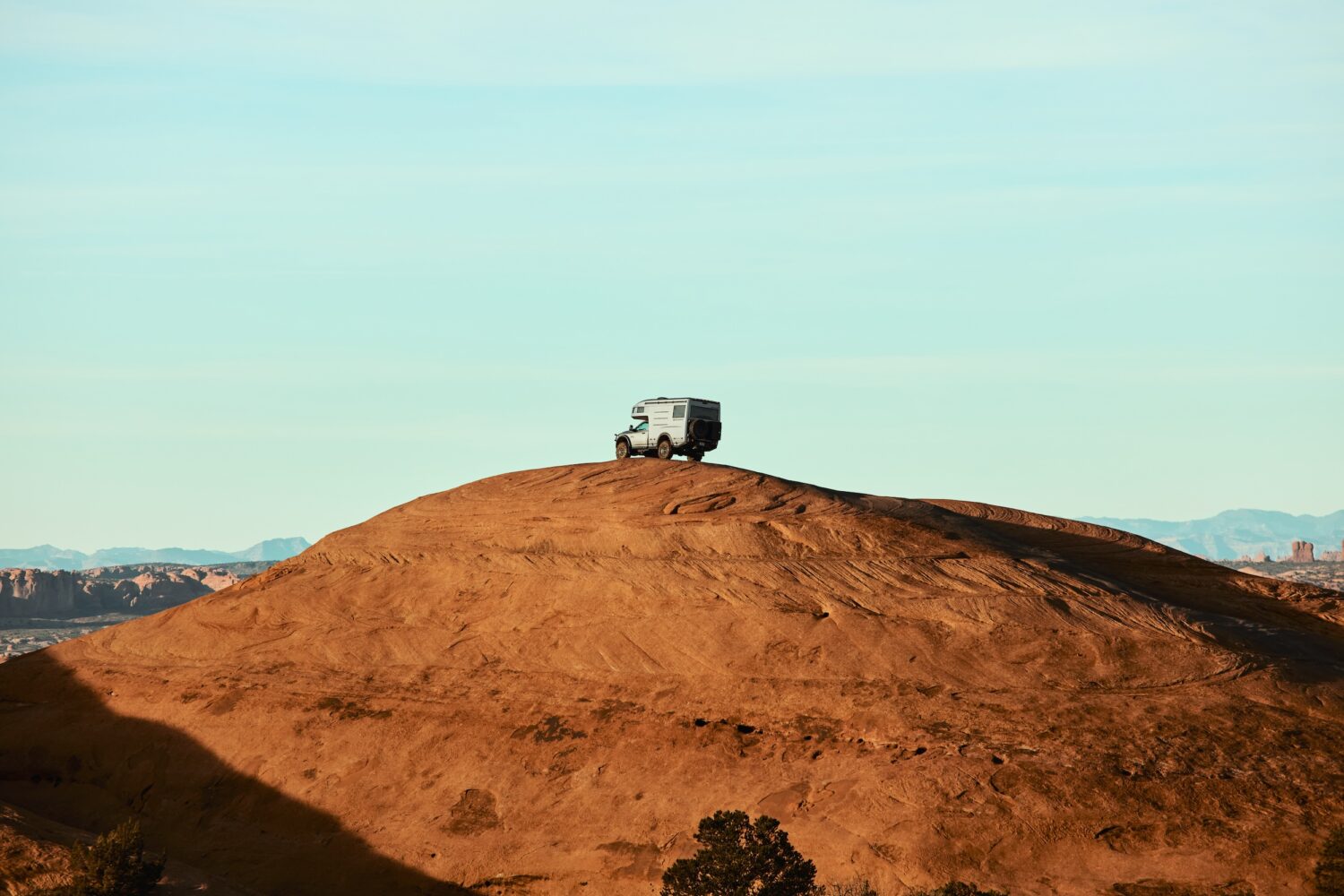
Summiting a petrified sand dune in Moab’s Sand Flats Recreation area. Photo by Max Hall
Tires That Go the Distance: A Game-changing Upgrade
Want to know the worst part of owning an expedition vehicle? It’s the tires. For regular four-wheel drives, the market offers a dizzying array of brands, tread patterns, and sizes. But for expedition vehicles, which have very specific requirements for load capacity and off-highway tread, the choices are painfully limited—so limited, in fact, that you can count viable options on one hand. Maybe.
There’s really only one tire that works: the Continental MPT-81. Sure, it’s durable and consistent in quality, but its massive carcass and aggressive tread pattern demand constant maintenance. And let’s not forget its maximum speed rating—a blistering 68 mph in its most popular size. Realistically, you’re looking at 3,000-mile rotations to eke out a 25,000-mile service life, and you’ll need to rebalance just as often. Adding insult to injury, these tires are typically mounted on three-piece beadlocks, which most tire shops won’t touch with a 10-foot pole. The result? A logistical nightmare, especially if you’re traveling internationally.
Now, contrast that with the 40-inch, F-Rated, BFGoodrich HD-Terrain tires on the TruckHouse BCR. Developed in collaboration with AEV, these tires are simply smarter. They strike a perfect balance between load capacity, durability, and on-road refinement, delivering a quieter, smoother ride. They are far easier to replace and, crucially, don’t require the constant attention that the MPT-81s demand. As an added bonus, they’re available through any tire shop that offers BFGoodrich products, whereas the MPT-81, despite being a Continental product, is only available through commercial tire centers, where it’s still scarce and obscure.
One moment perfectly illustrates the difference. Last summer, I embarked on a last-minute trip to attend the launch party for the XOverland Ranch in Three Forks, Montana. My local shop couldn’t balance or rotate the MPT-81s on my older EarthRoamer LTS before I left, so I spent thousands of miles wobbling and shaking my way there and back. To add insult to injury, as the event wrapped up, a prototype TruckHouse BCR casually passed me at 85 mph, cruising smoothly on its HD-Terrains while I struggled to keep my EarthRoamer steady at 55 mph due to my unbalanced tires.
It’s the single best argument I can offer for the TruckHouse BCR. Normal tires. Normal serviceability. Any tire shop can handle them. Any Ram dealer can service a 3500. I love my EarthRoamer, but struggle to come up with anecdotes for how much I hate dealing with the MPT-81 tires. Their constant need for attention is the number one problem with larger—and heavier—expedition vehicles. And this is my number one argument for the more compact and lighter TruckHouse BCR.
Let’s be fair, the tire problem is certainly not exclusive to EarthRoamer—pick anything larger than the BCR and you’re going to have the same issues—just worse. European expedition trucks, such as those built on a MAN chassis, often wear specialty tires in unique sizes that approach 50 inches with speed ratings well below those of the MPT-81s on my LTS. Good luck finding a set of those in Bolivia or Côte d’Ivoire.
You’re probably wondering why I’m spending so much time ranting about tires—but I’m offering you real-world experience about the Achilles heel of expedition vehicles, the kind of stuff owners talk about around the campfire. It’s not just the more nimble size of the TruckHouse BCR that has me considering one for my upcoming Pan-American Highway trip. It’s the fact that I know in my LTS, every second and every minute that I’m driving, I’ll have some aspect of those MPT-81s on my mind.
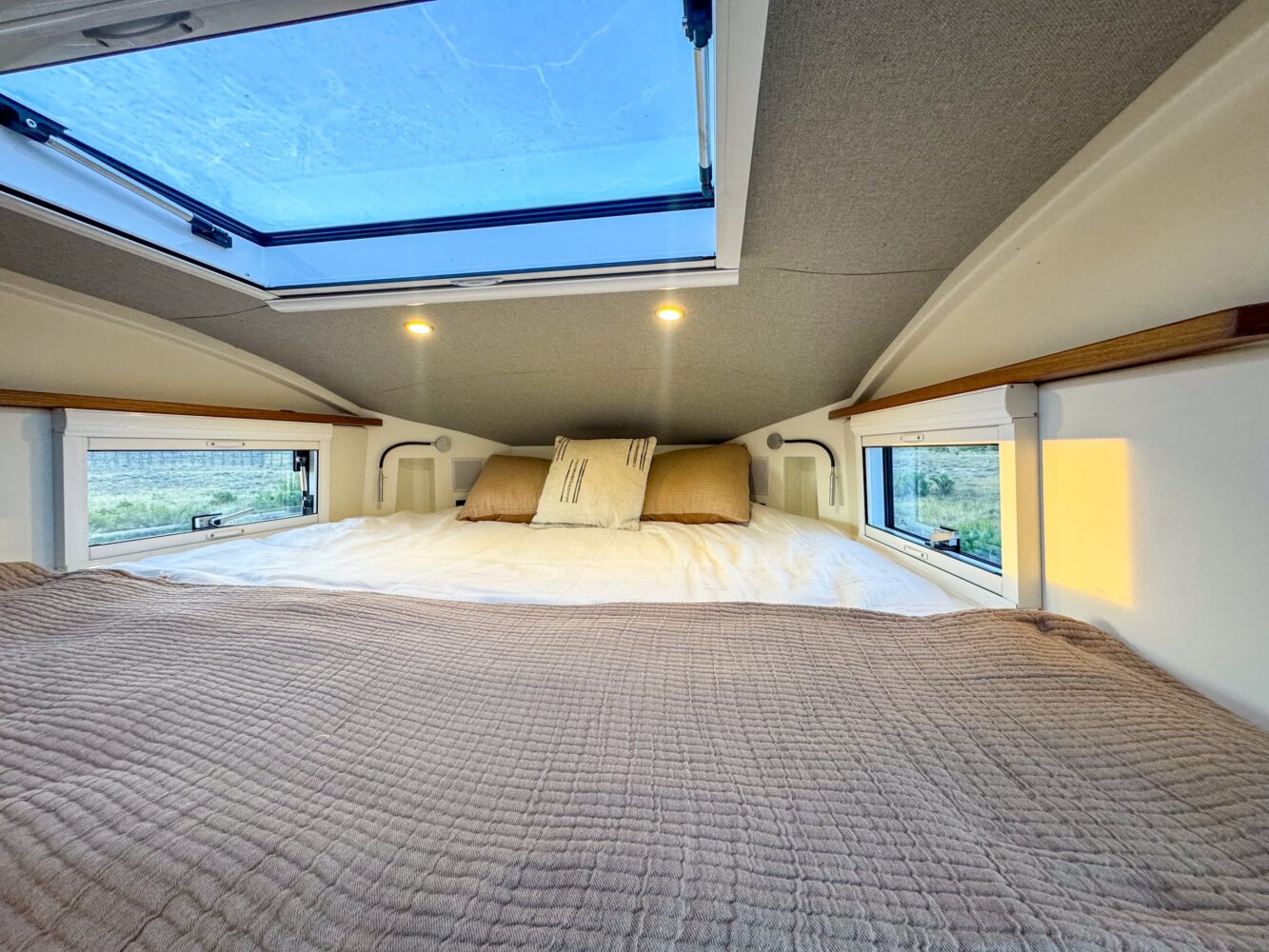
Side windows allow for cross flow of air, and a hatch allows for roof access. Photo byTruckHouse
Two Philosophies, Two Audiences: Luxury vs. Adventure
EarthRoamer and TruckHouse take markedly different approaches to the expedition vehicle market. EarthRoamer leans heavily into luxury, offering features like granite countertops, a wine rack, and extensive storage that make it the ultimate home on wheels. However, its nearly 19,000-pound weight and extended dimensions position it more for comfort than pushing boundaries. Built on an 84-inch, cab-to-axle chassis, the EarthRoamer extends approximately 40 inches beyond the rear axle—over 2 feet more wheelbase and an additional 25 inches of rear overhang compared to the TruckHouse. The BCR, in contrast, utilizes a 60-inch, cab-to-axle chassis with just 14.5 inches of rear extension. This stark difference in proportions has tangible implications in the real world—tight trails and technical terrain often necessitate turning back in the EarthRoamer, even for the most experienced drivers like myself.
TruckHouse, by contrast, is purpose-built for adventurers who value venturing deeper into the wilderness and tackling more technical recreational four-wheel drive routes, like those in Moab. While its 40-gallon water tank and more compact living space may seem like compromises compared to the EarthRoamer’s 100-gallon tank and spacious interior, these trade-offs allow access to destinations that would be off-limits for larger vehicles. Admittedly, the EarthRoamer’s larger interior and massive water tank are great for long, luxurious showers in remote locations, but it also necessitates a heavier-duty chassis to support the increased weight—further contributing to its size.
That said, it’s unfair to characterize the EarthRoamer as cumbersome or incapable. My personal experience has shown it to be surprisingly nimble for its size, thanks to its wide-track axle that allows for a greater wheel cut compared to the Ram 3500 chassis beneath the BCR. It’s a testament to how well EarthRoamer has optimized the F-550 platform for off-road capability despite its bulk.
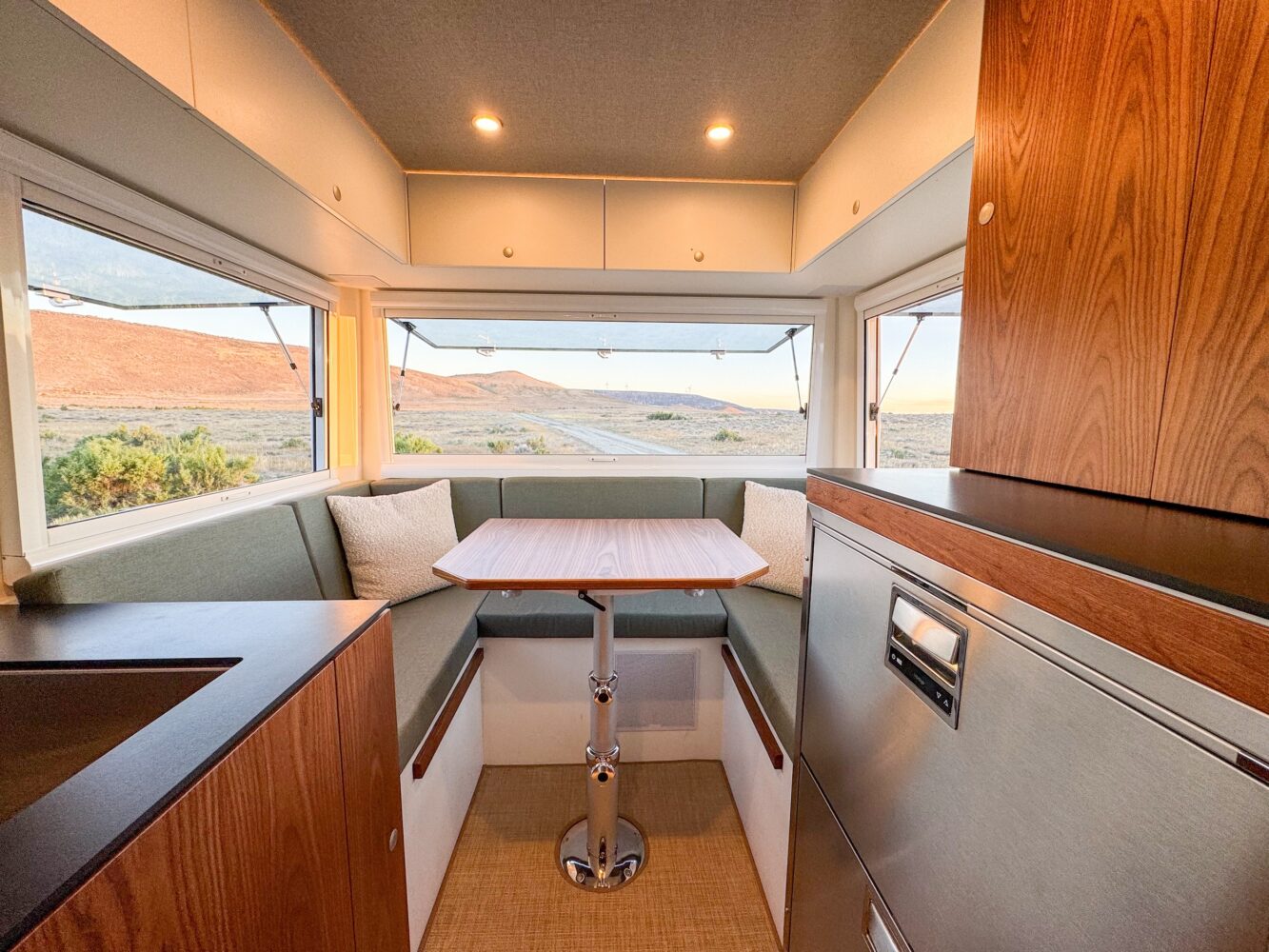
The rear dinette converts from a comfortable lounge into a bed. Photo by TruckHouse
Expedition Dreams at Different Price Points
Both the EarthRoamer LTX and TruckHouse BCR occupy the high end of the expedition vehicle market, but their price points reflect different philosophies. The EarthRoamer LTX starts at $798,000, with fully optioned models bounding at the ceiling of a million bucks. This isn’t to say the EarthRoamer is overpriced. I like to say that it’s the closest thing you can get to a five-star hotel with a million-star view in the backcountry—whereas the TruckHouse BCR takes a different approach altogether—which isn’t to say that it doesn’t have a bit of luxury in its own right. Heated floors are a tempting option on the BCR, but I’m afraid there’s no wine rack.
Base pricing for the TruckHouse BCR starts at $485,000 and includes the AEV Prospector XL conversion on a Ram 3500 Cab and Chassis with a gasoline drivetrain—a better option for international travel these days, if I’m being honest. Options are plentiful, with high-spec BCRs landing in the $550,000-$595,000 range. When I built out my dream TruckHouse BCR, with a couple of options like the integrated Starlink High-Performance Dish, a larger 600-watt solar array, a few AEV upgrades, and a 48-volt air-conditioning system, the price came out to around $525,000—including my choice of a diesel Ram chassis.

Soft sand is typically a nightmare scenario for expedition vehicles. Photo by AJ Van de Water
Redefining Exploration: The Future of Overland Travel
TruckHouse has redefined the expedition vehicle landscape by prioritizing efficiency, reliability, and real-world usability. The BCR isn’t just a lighter, nimbler alternative to larger rigs—it’s a thoughtfully engineered machine that invites adventurers to explore further without sacrificing comfort.
For those who dream of pushing boundaries and venturing off the beaten path, the TruckHouse BCR offers an enticing glimpse into the future of overland travel. While the EarthRoamer remains the pinnacle of luxury, the BCR represents a new kind of freedom—one that’s lighter, more agile, and perfectly suited for the next generation of explorers. For me, it’s the first vehicle that has truly made me question whether bigger is always better. I might just end up with one myself.
Read More: The Land Rover Defender X-Dynamic :: A Modern Off-Road Icon with Flawed Charm
Our No Compromise Clause: We do not accept advertorial content or allow advertising to influence our coverage, and our contributors are guaranteed editorial independence. Overland International may earn a small commission from affiliate links included in this article. We appreciate your support.


